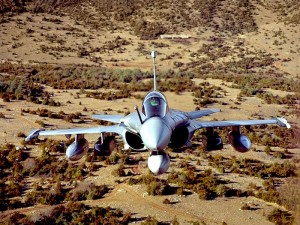by Robbin Laird
2012 is perhaps a turning point year in the global fighter market. India’s downselect of the Rafale and the possible selection by Brazil of the same aircraft could have some game changing qualities.
First, if this were to occur, this would mean that the US is down in the fighter market to global support of already sold legacy aircraft, FMS sales of legacy aircraft and the F-35. And the way Inside the Beltway has been supporting the F-35, the program could become globally challenged. The President has made it clear that he wants to see a doubling of US exports in the next five years; but the fighter world will not contribute much to this effort if the Administration does not accelerate its OWN purchases of the F-35 and reducing fly away cost by so doing. Just having more layers of oversight domestically over a program ready to build combat aircraft is hardly a way to promote exports.
Second, both the Indians and the Brazilians have one core objective in common in making their fighter selections: to add capability for now and to build domestic capacity to shape a global product. In many ways, Embraer is better placed than Indian firms to sort out the globally exportable Rafale or son of Rafale. The purchase of the current product is simply a down payment in shaping a global export product.

Third, one needs to be perfectly clear – this is NOT an export of aircraft from France to India and/or Brazil. Currently, Dassault builds only 1 ½ Rafales per month and has done so at this level because of reductions on French government orders. There is little real capacity to provide the kind of significant technology transfer FROM France that either India or Brazil would wish for.
Fourth, what the SALE of Rafale to India and/or Brazil would really amount to is the crafting of capabilities in both India and Brazil to build this aircraft and then shape a globally effective export strategy for the next round. No one should doubt the ability of Embraer to know markets or to shape an effective export strategy.
As Reuben Johnson commented in an interview on the website:
I will tell you right now and I have seen in my lifetime many, many, many, many briefings by aerospace companies about what they think the market is. Embraer is by far the smartest company I’ve ever seen about looking at a market and saying, okay over the next X number of years there’s going to be so many opportunities to sell X-type of aircraft. And we think realistically we can get this percentage of it and that works out to so many numbers.
They’re not like American companies that no matter what you ask them, they always say that they can get 50% of anything. Which is just not realistic. They’re very smart about that, they’ve been very smart about the way they develop the airplane.
One real possibility is that Embraer works with Indian firms to shape an evolving air combat product and or product line. The Indians clearly have an opportunity working with European firms and Embraer to shape a migration path to build a modern infrastructure for developing and manufacturing modern combat aircraft. And make no mistake about it, the suppliers for military aircraft will migrate along with the market.
It is important to note that the firms supplying or supporting the air combat systems houses often are more important than those houses themselves. With regard to India, it is clearly the case that THALES India, a key enabler for the Rafale, was the key to success for Dassault.
There will be a need as well for aeronautical engineers who speak English and perhaps those folks in Europe and the US who cannot find a good fit for their skills can enjoy life in Brazil or India.
This would mean that a product produced in the BRICS would join those of China and Russia in shaping a robust and capable global combat aircraft market for the next thirty years.
This would mean that comments such as those made inside the beltway that the “F-35 will be the last combat aircraft ever built” would be reduced to vaporware.
Why are these countries so misinformed when coming to meeting their own future needs?
Perhaps it is that having looked back at the last decade, they have seen how significant and FLEXIBLE combat air is to operate.
Perhaps it is because of the capability, which a fleet of combat aircraft can deliver, due to the power plants carried onboard.
Perhaps it is because virtually any combat aircraft is more survivable than an unmanned vehicle.
Perhaps it is because these folks don’t want to simply own flying data nodes, but real combat capabilities.
And perhaps they look at the real costs of ownership of the larger UAVs and recognize the VERY significant manpower, survivability and ops costs. Given the loss rates of larger UAVs in Afghanistan, it is clear to most folks that replacement costs are part of real operational costs.
In other words, if Washington does not accelerate its support for the F-35 as a global product, others will meet the global fighter market. There is no plan B in the United States; there certainly is outside of the United States.
(For a view of the French Chief of Staff of the Air Force on the impact of the sale to India see
https://www.sldinfo.com/fr/2012/vente-de-rafale-en-inde-le-point-de-vue-du-cemaa/)

